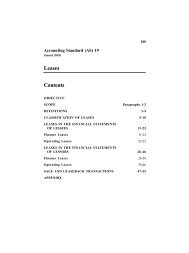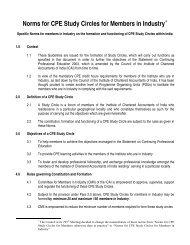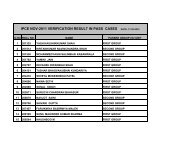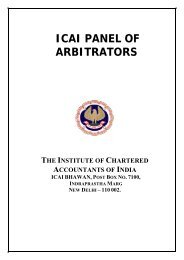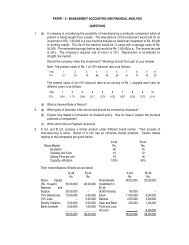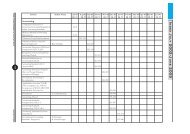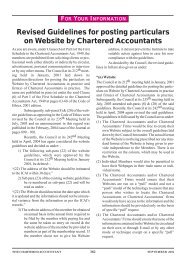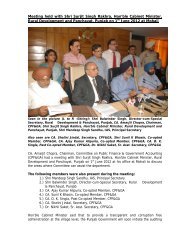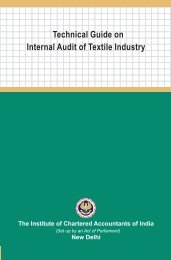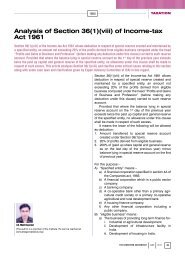The Chartered Accountant
The Chartered Accountant
The Chartered Accountant
You also want an ePaper? Increase the reach of your titles
YUMPU automatically turns print PDFs into web optimized ePapers that Google loves.
PRACTICE UPDATE<br />
Enhancing Audit Quality<br />
With a view to apprise the members of the Institute and others concerned about the major non-compliances<br />
observed during the review, the Financial Reporting Review Board (FRRB) compiles such<br />
non-compliances from time to time and publishes the same in the Journal. Continuing the same practice,<br />
following are the some of the common non-compliances observed by the Board during review of<br />
general-purpose financial statements of certain enterprises and auditors’ reports thereon:<br />
I Accounting Standards (AS)<br />
AS 2, Valuation of Inventories<br />
1. AS 2, Valuation of Inventories, requires all inventories,<br />
including raw materials, packing materials<br />
and consumables & stores, to be valued<br />
at lower of cost and net realisable value. In few<br />
cases, the accounting policy of few enterprises<br />
provides that raw materials, packing materials<br />
and consumables & stores are valued at the cost/<br />
weighted average cost. In other words, some enterprises<br />
do not consider net realisable value in<br />
the valuation of raw materials, packing materials<br />
and consumables & stores, which is contrary to<br />
the requirements of AS 2.<br />
2. Paragraph 26 of the AS 2, dealing with disclosure<br />
requires that the financial statements<br />
should disclose:<br />
l the accounting policies adopted in measuring<br />
inventories, including the cost formula<br />
used; and<br />
l the total carrying amount of inventories<br />
and its classification appropriate to the enterprise.<br />
Some enterprises do not disclose the method<br />
of valuation of inventories i.e. whether FIFO/<br />
LIFO or other method in their accounting<br />
policy on Inventories, which is contrary to the<br />
requirements of AS 2.<br />
AS 3, Cash Flow Statements<br />
3. As per paragraph 30 of AS 3, Cash Flow Statements,<br />
interest paid has to be classified as cash<br />
flow from financing activities. Few enterprises<br />
have shown interest paid as cash flow from investing<br />
activities, which is not as per AS 3.<br />
AS 5, Net Profit or Loss for the Period, Prior Period<br />
Items and Changes in Accounting Policies<br />
4. As per AS 5, Net Profit or Loss for the Period,<br />
Prior Period Items and Changes in Accounting<br />
Policies, prior period items are income or<br />
expense which arise in the current period as a<br />
result of error or omissions in the preparation<br />
of the financial statements of one or more prior<br />
periods. Some enterprises have adjusted the<br />
Balances/Liabilities that are no longer required<br />
relating to earlier years or written off in earlier<br />
years under the head prior period adjustments<br />
in the profit & loss account, which is contrary<br />
to AS 5.<br />
AS 9, Revenue Recognition<br />
5. Accounting Standards Interpretation (ASI) 14,<br />
‘Disclosure of Revenue from Sales Transactions’<br />
(Re. AS 9, Revenue Recognition) requires<br />
that the amount of turnover should be disclosed<br />
in the following manner on the face of<br />
the statement of profit and loss:<br />
Turnover (Gross) xx<br />
Less: Excise Duty xx<br />
Turnover (Net) xx<br />
Some enterprises disclose sales (net of excise<br />
duty) on the face of the profit and loss account<br />
and the amount of excise duty is shown as deduction<br />
from sales in the Schedule to the profit and<br />
loss account, which is contrary to the Accounting<br />
Standards Interpretation (ASI) 14.<br />
AS 13, Accounting for Investments<br />
6. Paragraph 26 of AS 13, Accounting for Investments,<br />
requires that an enterprise should<br />
disclose current investments and long-term investments<br />
distinctly in its financial statements.<br />
Some enterprises classify the investments into<br />
two categories, viz., (i) Non-trade (Quoted),<br />
and (ii) Unquoted but do not disclose the classification<br />
of investment as required by AS 13<br />
either in their Schedule or in the notes to accounts.<br />
7. AS 13, Accounting for Investments, requires<br />
provision to be created to recognise a decline,<br />
other than temporary, in the value of long-term<br />
investments. Some enterprises use the term<br />
permanent diminution instead of other than<br />
temporary, which is contrary to the requirements<br />
of AS 13. It may be noted that there is<br />
a difference between ‘permanent diminution<br />
in the value of investments’ and ‘other than<br />
temporary diminution in value of investments’<br />
and normally, no diminution in value of investments<br />
may be termed as permanent.<br />
(to be continued………)<br />
THE CHARTERED ACCOUNTANT 1033 DECEMBER 2008



